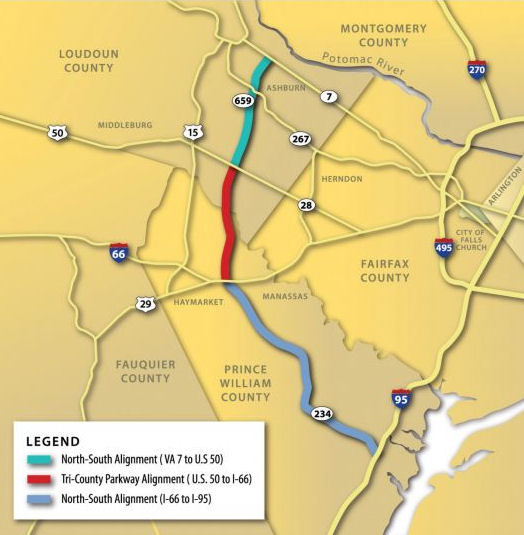About Bacon’s Rebellion
Bacon's Rebellion is Virginia's leading independent portal for news, opinions and analysis about state, regional and local public policy. Read more about us here.
A North-South Highway for Northern Virginia
The McDonnell administration has unveiled its vision for a north-south highway and other improvements to Virginia's newest Corridor of Statewide Significance.
Edit

by James A. Bacon
The McDonnell administration has unveiled a recommended alignment for a limited access highway to be built as the backbone of the North-South Corridor of Statewide Significance in Northern Virginia. The 45-mile circumferential highway would start at Interstate 95 in the south, swing west of Dulles International Airport and terminate at Route 7 in the north.
The route would following existing highways, roads and projects contained in the comprehensive plans of Prince William County and Loudoun County. In a brief presentation of the proposal yesterday to the Commonwealth Transportation Board, Deputy Secretary of Transportation David Tyeryar justified the project on the grounds that it would help Dulles airport compete in the air cargo arena and would serve an area on the fringe of metropolitan Washington whose population is expected to grow by hundreds of thousands over the next three decades.
Although Tyeryar noted that the highway would provide an estimated $3.9 million a year in annual travel-time savings, he did not tell the CTB what the facility was estimated to cost. No one on the CTB asked. However, answering questions after the presentation, Dironna Moore Belton, policy program manager for the Office of Intermodal Planning and Investment, gave a rough estimate of $1 billion to be financed by a yet-to-be-determined mix of local, state and private dollars.
The presentation inspired a sharp rebuke from Stewart Schwartz, executive director of the Coalition for Smarter Growth. "I thought it was a very thin presentation. It failed in the most basic way by not even providing a price or a detailed explanation of what they were proposing." The cost of the circumferential highway does not include a connector to Dulles airport or proposed upgrades to Rt. 606 running along the western edge of the airport, which could add another $500 million, he said. Tyeryar provided no Return on Investment analysis, Schwartz added, nor, given Northern Virginia's many transportation needs, did he address alternative uses of public funds.
No money has been allocated to the project, Tyeryar said. The McDonnell administration has simply laid out its vision for the corridor. Before anything gets built, the eight segments of the proposed highway need to be studied in significantly more detail and gain approvals from local governments and Northern Virginia's regional transportation planning organization. Segments will be constructed piece-meal as money becomes available. No action from the CTB was needed yesterday.
The project has been a top priority for Gary Garczynski, Northern Virginia district representative for the CTB. "This is a blueprint for the future," he said. "We still have challenges. We're asking for acceptance of this study to be continued."
In making his presentation, Tyeryar summarized the findings of the just-released "Northern Virginia North-South Corridor of Statewide Significance Corridor Master Plan." The deputy transportation secretary, a former Prince William County budget director, has acted as the McDonnell administration's point man on the project through a series of public presentations and official public hearings over the past several months.
The Master Plan provides a detailed description of the McDonnell administration's vision for the corridor, which the CTB had designated as a Corridor of Statewide Significance in 2011. Key elements include:
- Construction of a continuous high-occupancy vehicle (HOV) facility between I-95 and the area west of Washington Dulles International Airport, which
would operate during peak periods in the morning and evening.
- Establishment of a high-occupancy toll (HOT) system
between Route 234 and Dulles airport. Vehicles carrying three or
more persons would be able to access the system at no cost, and
other vehicles would pay a toll to access the HOV/HOT lanes during peak
periods.
- Construction of a new road between the North-South
Corridor and Dulles airport to improve regional and statewide access to the
airport, surrounding freight facilities and the Metrorail Silver Line.
- Provision of new and expanded transit services connecting activity centers in the corridor. These services would provide north-south
mobility as well as connections for east-west travelers at convenient locations such as park-and-rides and rail
stations.
- Construction of a trail along the Corridor for the use of bicyclists and pedestrians, allowing them to access activity centers
throughout the north-south corridor seamlessly.
- Improvements to transportation demand management programs (TDM) within the Corridor, focused on marketing and promotion of the expanded transit services and the HOV network.
Tyeryar chacterized the report as the result of collective with Loudoun County and Prince William County. All segments of the proposed highway can be found already in county transportation plans. "We took existing segments of roads and linked them together."
Some segments might prove attractive to the private sector, which could finance construction through tolls generated on express lanes, said Belton, with the OIPI.
Tyeryar listed five goals to be supported by the corridor vision, including economic development, safe travel, multimodal investment and environmental stewardship. Consistent with Governor Bob McDonnell's emphasis on using transportation improvements to spur economic growth, Tyeryar focused mainly on the economic development justification in his remarks.
In McDonnell's view, Dulles airport and the Hampton Roads ports are economic drivers for the state. "International ports of entry are a very high priority to us," Tyeryar said. Dulles, though not a major air cargo airport at present, has the potential to become one. He cited a study forecasting the potential for air cargo to generate up to $250 million in wages in and around the airport.
The deputy transportation secretary also noted that the north-south corridor will see enormous population growth. In an apparent reference to the successful effort a decade ago by smart growth groups to block a proposed outer beltway along a similar route, he said, "The prevailing wisdom is that if you don't build the road, the growth won't occur. Not true. The growth occurred anyway."
Schwartz with the Coalition for Smarter Growth is not impressed with the administration's logic. "They used growth projections in a misleading manner," he says. The map in Tyeryar's presentation suggests that the projected population will move in a circumferential manner. In fact, most growth will continue to move radially toward job centers closer to the urban core, as currently is the case.
Also, Schwartz says, "They failed to note that the growth projections themselves are a political exercise reflecting the planning goals and dreams of the counties, but not necessarily what actually may happen." Changing demographics, changing market demand and chronically higher gas prices are all having an impact that is "likely to dampen outer suburban growth and favor growth closer to jobs and closer to transit."
“The inadequacies of the Secretary of Transportation’s Office of Intermodal Policy and Investment (OIPI) analysis should be of great concern to every taxpayer, given the billions of dollars under VDOT’s control," said Schwartz in an email response. "This relatively new office was supposed to do a better job of integrated planning, but they’ve failed here. I think it’s time that an independent, multi-sector agency in state government lead the planning and prioritization of transportation projects, separating planning from project delivery and integrating land use, economics, and other infrastructure needs into their considerations."
He continued: "VDOT does an excellent job at delivering projects, it’s just that they (and now the OIPI) are too often failing to objectively analyze alternatives, failing to look at return on investment and to compare to other potential transportation needs, failing to use more cost effective land use and demand management approaches, failing to address our maintenance backlogs, and squandering tax-dollars on projects of questionable value.”

